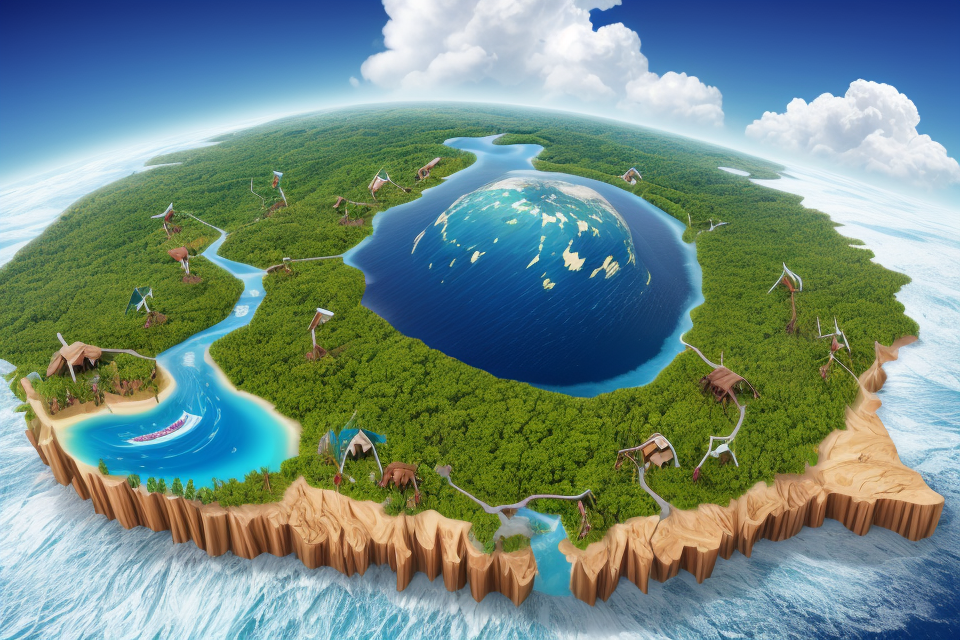
The world we live in is facing a multitude of environmental issues that are impacting our planet and its inhabitants. These issues range from climate change to pollution, deforestation to overfishing, and they all have serious consequences for our future. In this article, we will explore the three main types of environmental issues that are currently plaguing our planet. We will delve into the causes, effects, and potential solutions for each issue, providing a comprehensive overview of the challenges we face and the actions we can take to address them. Whether you are a concerned citizen or a budding environmentalist, this article will provide you with the information you need to understand the state of our planet and take action to protect it.
The three main types of environmental issues are pollution, resource depletion, and climate change. Pollution refers to the presence or introduction into the environment of substances or energy that cause harm or discomfort to living organisms. Resource depletion refers to the overuse or depletion of natural resources, such as water, land, and forests, which can lead to their degradation and loss. Climate change refers to the long-term changes in the Earth’s climate patterns, including global warming, sea level rise, and changes in precipitation patterns, which can have significant impacts on ecosystems, human populations, and economic systems. All three of these environmental issues are interconnected and can have serious consequences for the health and well-being of people and the planet.
Understanding Environmental Issues
Environmental Issues Defined
Environmental issues refer to problems that affect the natural world and the living organisms that inhabit it. These issues can range from air and water pollution to climate change and deforestation. The causes of environmental issues are often linked to human activities, such as industrialization, urbanization, and the burning of fossil fuels.
One of the main reasons why environmental issues are important is that they can have significant impacts on human health and well-being. For example, exposure to air pollution can lead to respiratory problems, while contaminated water can cause a range of health issues, including digestive problems and cancer. Additionally, environmental issues can have negative impacts on the economy, including damage to infrastructure and loss of natural resources.
Another reason why environmental issues are important is that they can have significant impacts on the natural world. For example, deforestation can lead to habitat loss for endangered species, while climate change can disrupt ecosystems and cause extinctions. These impacts can have cascading effects on the environment, leading to further problems down the line.
Understanding environmental issues is essential for developing effective solutions to these problems. By identifying the root causes of environmental issues, we can develop targeted interventions that address the specific causes of these problems. Additionally, by understanding the impacts of environmental issues on human health and the natural world, we can develop policies and regulations that protect the environment and promote sustainable development.
The Three Main Types of Environmental Issues
The three main types of environmental issues can be broadly categorized as follows:
- Pollution: This type of environmental issue refers to the presence or introduction into the environment of substances or energy that cause adverse effects on living organisms or ecosystems. Examples of pollution include air pollution, water pollution, and soil pollution. Pollution can occur as a result of human activities such as industrial processes, transportation, and agriculture.
- Depletion: This type of environmental issue refers to the excessive use or extraction of natural resources, leading to their depletion or exhaustion. Examples of depletion include deforestation, overfishing, and oil depletion. Depletion can occur as a result of human activities such as industrialization, urbanization, and population growth.
- Climate Change: This type of environmental issue refers to the long-term changes in the Earth’s climate patterns, which have been caused by human activities such as the burning of fossil fuels, deforestation, and land-use changes. Climate change can lead to various impacts, including rising sea levels, more frequent and severe weather events, and changes in precipitation patterns.
Each of these types of environmental issues has its own characteristics and impacts on the environment and human societies. It is important to understand these issues in order to develop effective strategies for mitigating their effects and protecting the environment.
Types of Environmental Issues
Pollution
Pollution refers to the presence or introduction into the environment of substances or energy that cause adverse effects, hazards, or harm to living organisms, ecosystems, or ecological balances. It can occur in various forms, including air, water, and soil pollution. The different types of pollution include:
- Air Pollution:
Air pollution occurs when harmful or excessive amounts of gases, particles, or other substances are introduced into the air. These substances can be released into the atmosphere through natural processes, such as volcanic eruptions, or through human activities, such as the burning of fossil fuels, industrial processes, and transportation. Common examples of air pollutants include carbon monoxide, nitrogen oxides, sulfur dioxide, and particulate matter. Air pollution can have serious effects on human health, including respiratory problems, heart disease, and cancer, as well as damage to crops, forests, and other natural resources. - Water Pollution:
Water pollution occurs when harmful or excessive amounts of substances are introduced into bodies of water, such as rivers, lakes, and oceans. These substances can include industrial and agricultural waste, sewage, chemicals, and plastics. Water pollution can have serious effects on aquatic ecosystems, including the death of fish and other aquatic organisms, and can also impact human health through the consumption of contaminated water. - Soil Pollution:
Soil pollution occurs when harmful or excessive amounts of substances are introduced into the soil, such as industrial and agricultural waste, pesticides, and heavy metals. Soil pollution can have serious effects on plant and animal life, as well as on human health, as it can impact the quality and safety of the food we eat.
Solutions to reduce pollution include:
- Implementing stricter regulations and standards for industries and businesses to reduce their pollution output.
- Encouraging the use of clean energy sources, such as wind and solar power, to reduce the burning of fossil fuels.
- Promoting sustainable agriculture and reducing the use of harmful pesticides and fertilizers.
- Improving waste management practices, such as recycling and proper disposal, to reduce the amount of waste released into the environment.
- Increasing public awareness and education about the importance of environmental protection and the impact of individual actions on the environment.
Climate Change
Climate change refers to the long-term warming of the planet due to an increase in global temperatures. This phenomenon is caused by human activities such as burning fossil fuels, deforestation, and agriculture, which lead to an increase in the concentration of greenhouse gases in the atmosphere.
Effects of Climate Change on the Environment
- Rising sea levels and coastal flooding
- More frequent and severe heatwaves, droughts, and wildfires
- Changes in precipitation patterns and increased frequency of extreme weather events
- Shifts in ecosystems and habitats, leading to the extinction of species
- Disruption of food production and supply chains
Solutions to Mitigate Climate Change
- Reducing greenhouse gas emissions through the use of renewable energy sources, energy efficiency, and sustainable transportation
- Protecting and reforestation to remove carbon dioxide from the atmosphere
- Implementing policies and regulations to limit carbon emissions and promote sustainable practices
- Supporting research and development of new technologies to reduce carbon emissions and promote sustainability.
Depletion of Natural Resources
The depletion of natural resources is one of the most pressing environmental issues of our time. It refers to the overuse and exploitation of natural resources such as water, soil, minerals, and forests, which are essential for the survival of humans and other species. The depletion of natural resources has severe consequences on the environment, including soil erosion, desertification, and the loss of biodiversity.
One of the main causes of the depletion of natural resources is human population growth, which has led to an increase in demand for food, water, and energy. This has resulted in the overuse of natural resources, such as deforestation, overfishing, and the overuse of fertilizers and pesticides, which can lead to soil degradation and water pollution.
Another major cause of the depletion of natural resources is the industrialization and urbanization of society, which has led to an increase in energy consumption and the production of waste. This has resulted in the depletion of fossil fuels, such as coal and oil, and the release of greenhouse gases, which contribute to climate change.
To preserve natural resources, it is essential to adopt sustainable practices, such as reducing energy consumption, using renewable energy sources, and promoting sustainable agriculture and forestry. This can be achieved through policies and regulations that encourage the use of clean technologies, the protection of natural habitats, and the promotion of sustainable lifestyles.
In conclusion, the depletion of natural resources is a major environmental issue that has severe consequences on the environment and human well-being. To address this issue, it is essential to adopt sustainable practices and promote policies and regulations that encourage the use of clean technologies and the protection of natural habitats.
Other Environmental Issues
Biodiversity Loss
Biodiversity loss refers to the decline in the variety of plant and animal species that exist on Earth. This decline is primarily caused by human activities, such as deforestation, habitat destruction, and pollution. The loss of biodiversity has far-reaching consequences for the environment, including a reduction in the ability of ecosystems to provide essential services, such as clean air and water, and the potential for extinction of many species.
There are several causes of biodiversity loss, including:
- Habitat destruction: As human populations grow, more land is needed for agriculture, urbanization, and other purposes, leading to the destruction of natural habitats.
- Pollution: Pollution from agriculture, industry, and transportation can harm wildlife and disrupt ecosystems.
- Climate change: Climate change is causing shifts in the timing of seasonal events, such as migration and flowering, which can disrupt the relationships between different species.
- Overexploitation: Overfishing, hunting, and harvesting of wild plants and animals can cause declines in populations and even extinction.
To preserve biodiversity, it is important to take action to reduce the causes of biodiversity loss. This can include:
- Protecting and restoring habitats: This can be done through the creation of protected areas, such as national parks and wildlife refuges, and the restoration of degraded habitats.
- Reducing pollution: Governments and industries can take steps to reduce pollution, such as implementing regulations and investing in cleaner technologies.
- Addressing climate change: Addressing climate change through the reduction of greenhouse gas emissions can help to slow the rate of biodiversity loss.
- Promoting sustainable use of resources: This can include sustainable fishing and forestry practices, and promoting the use of renewable resources.
In conclusion, biodiversity loss is a significant environmental issue that can have far-reaching consequences for the environment and human well-being. To address this issue, it is important to take action to reduce the causes of biodiversity loss and to promote the conservation and restoration of natural habitats.
Land Use Change
Land use change refers to the modification of how land is utilized for various purposes, such as agriculture, forestry, urbanization, and mining. It is a significant environmental issue as it can lead to several negative consequences, including habitat loss, biodiversity degradation, and greenhouse gas emissions.
Causes of Land Use Change
There are several factors that contribute to land use change, including population growth, economic development, technological advancements, and government policies. As the global population grows, there is an increasing demand for food, water, and energy, which leads to the conversion of natural habitats into agricultural lands or urban areas. Economic development and technological advancements also contribute to land use change by increasing the efficiency of resource extraction and production, leading to the expansion of industries such as mining and logging. Finally, government policies, such as subsidies for agriculture or infrastructure development, can incentivize land use change and contribute to its acceleration.
Effects of Land Use Change
Land use change can have significant impacts on the environment, including habitat loss, biodiversity degradation, and greenhouse gas emissions. Habitat loss is a major concern as it can lead to the extinction of species and disrupt ecosystem functioning. Biodiversity degradation can also occur as a result of land use change, as the modification of natural habitats can lead to the introduction of invasive species and the loss of native species. Greenhouse gas emissions are another concern as land use change can contribute to deforestation, which releases carbon stored in trees and soil into the atmosphere, contributing to climate change.
Solutions to Sustainable Land Use
To address the environmental impacts of land use change, several solutions have been proposed, including sustainable agriculture, reforestation, and ecosystem restoration. Sustainable agriculture practices, such as agroforestry and conservation agriculture, can help to minimize the conversion of natural habitats while still meeting the demand for food and other resources. Reforestation can help to restore degraded lands and sequester carbon, while ecosystem restoration can help to re-establish the functioning of natural ecosystems.
Additionally, policies that incentivize sustainable land use, such as payments for ecosystem services and land use zoning, can help to reduce the negative impacts of land use change and promote more sustainable land use practices. Overall, addressing land use change is critical to achieving sustainable development and ensuring the long-term health of the planet.
Environmental Justice
Explanation of Environmental Justice
Environmental justice is a concept that refers to the fair distribution of environmental benefits and burdens among all individuals, regardless of their race, ethnicity, or socioeconomic status. It seeks to address the disproportionate impact of environmental hazards on marginalized communities, such as low-income communities and communities of color.
Importance of Environmental Justice
Environmental justice is important because it ensures that all individuals have access to a healthy and sustainable environment, regardless of their background or socioeconomic status. It also addresses the historical and systemic injustices that have resulted in the unequal distribution of environmental hazards and benefits.
Examples of Environmental Justice Issues
Some examples of environmental justice issues include:
- The disproportionate impact of pollution on low-income communities and communities of color.
- The lack of access to clean water and sanitation in marginalized communities.
- The unequal distribution of climate change impacts and the lack of access to resources to adapt to its effects.
Solutions to Promote Environmental Justice
To promote environmental justice, some solutions include:
- Increasing public participation in decision-making processes related to environmental issues.
- Implementing policies and regulations that ensure the fair distribution of environmental benefits and burdens.
- Providing resources and support to marginalized communities to address environmental hazards and promote sustainable development.
Overall, environmental justice is a critical aspect of addressing environmental issues and ensuring that all individuals have access to a healthy and sustainable environment.
FAQs
1. What are the three main types of environmental issues?
Answer:
The three main types of environmental issues are climate change, pollution, and biodiversity loss. Climate change refers to the long-term changes in the Earth’s climate patterns, which have been caused by human activities such as burning fossil fuels, deforestation, and agriculture. Pollution refers to the presence or introduction into the environment of substances that are harmful to living organisms. Biodiversity loss refers to the loss of species and ecosystems, which can have negative impacts on the functioning of ecosystems and the services they provide.
2. What is climate change?
Climate change refers to the long-term changes in the Earth’s climate patterns, which have been caused by human activities such as burning fossil fuels, deforestation, and agriculture. These activities have resulted in an increase in the concentration of greenhouse gases in the atmosphere, which trap heat and lead to a warming of the planet. This warming has far-reaching effects on the Earth’s natural systems and human societies, including rising sea levels, more frequent and severe weather events, and changes in precipitation patterns.
3. What is pollution?
Pollution refers to the presence or introduction into the environment of substances that are harmful to living organisms. There are many different types of pollution, including air pollution, water pollution, and soil pollution. Air pollution can be caused by the release of harmful gases and particles into the air, such as carbon monoxide, nitrogen oxides, and particulate matter. Water pollution can be caused by the release of harmful chemicals and nutrients into bodies of water, such as sewage, industrial waste, and agricultural runoff. Soil pollution can be caused by the release of harmful chemicals and heavy metals into the soil, which can make it difficult for plants and animals to grow and thrive.
4. What is biodiversity loss?
Biodiversity loss refers to the loss of species and ecosystems, which can have negative impacts on the functioning of ecosystems and the services they provide. Biodiversity loss can be caused by a variety of factors, including habitat destruction, overexploitation, and climate change. When species are lost, it can disrupt the balance of ecosystems and make them less resilient to change. This can have negative impacts on the services that ecosystems provide, such as clean air and water, food, and medicines.







